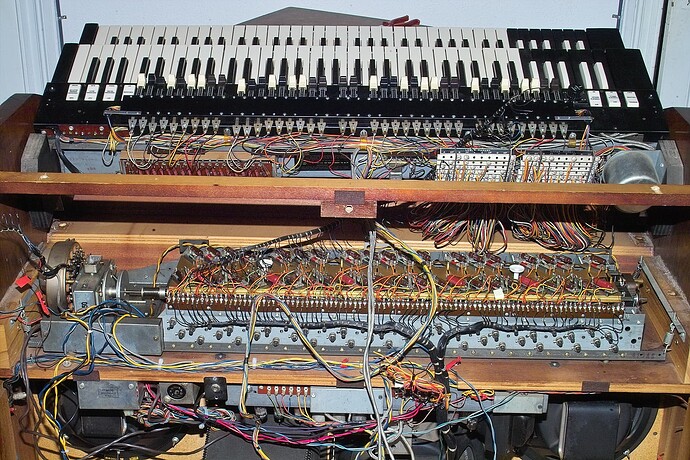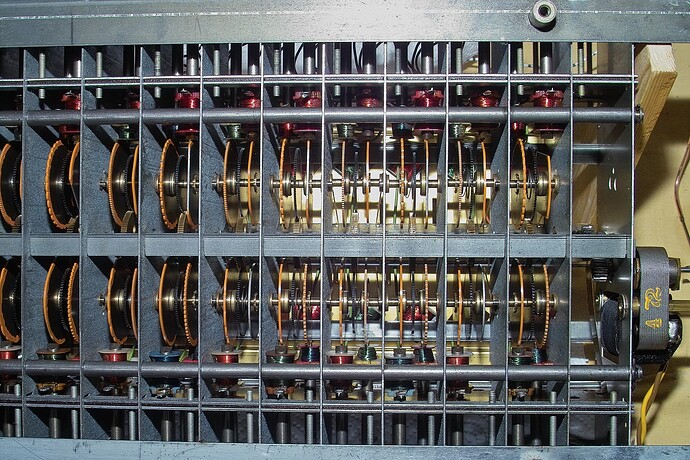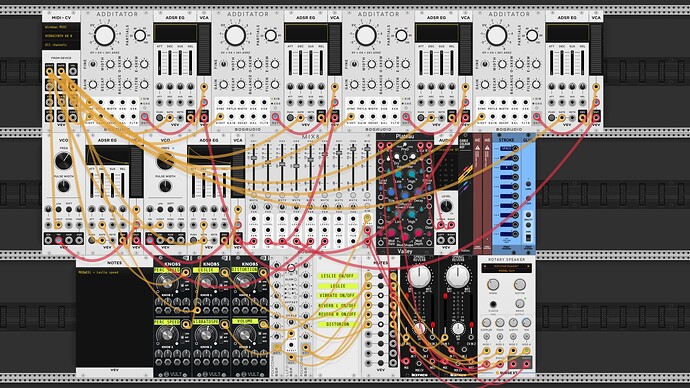Hi everyone, I’m attempting to create a church organ. For those of you who would like to give it a try, adjust your keyboard an octave higher. Enjoy! Here it is Church Organ.vcv (8.9 KB)
Really good sound - and flexible. Turn it up and bump up the reverb and I’m playing the Albert Hall organ. Now where did I put the sheet music for Toccata and Fuge in D minor…
Thanks for the nice comment. Have a creative day ![]()
Organ simulation can be done by starting with basic additive synthesis. So, a partials/harmonics series based approach. Sort of like how Hammond organs use drawbars to add ‘partials’ to the spectrum (though there’s a lot more to these electro-mechanical tonewheel organs).
A very simple, visual and intuitive approach to additive synthesis is using docB modules:
- Faders, offers 3 x 16 bipolar faders to set the levels of the partials/harmonics
- AddSynth, which offers CV inputs for 2 x 16 (using polyphony) partials/harmonics. AddSynth also offers more then just the sine waveform. There are some additive wave approximations, sin2, sin3, triangle, pulse and saw (that might be too ‘rich’ in harmonics for organ puposes).
- Pad, uPad2 and Pad2, offer Paul Nasca’s PADSynth algorithm. PADSynth is effectively a special kind of additive synthesis, where partials can have a ‘bandwidth’ instead of just being a single sine/frequency. Thus effectively also introducing some inharmonic/detuned spectral content in a very musically pleasant and effective way.
In your example you use a (highpass/lowpass/bandpass) filter approach on harmonically pure and rich spectra (saw/sqr, all/odd partials at 1/rank amplitude). So, without detuning the various oscillators relative fundamental frequencies, there’s no inharmonics/detuning present in a single voice. Thus producing an (unnaturally) pure spectrum.That’s where the Rotary speaker comes in, introducing doppler, combfilter and dampening effects to liven things up.
For the practical bit…
Just connect the (16 channel polyphonic) Faders output(s) to the equivalent (16 channel polyphonic) VCA/level input of the chosen (P)Add synth and set the sliders to your likings. This chain is monophonic, so duplicate for each polyphonic voice.
You can use something like VCV Split to split incoming polyphonic V/Oct and gates (e.g. from keyboard) into separate monophonic channels. Mixing back to a mono channel is often implicitly done by mixers at their inputs. But you can also use something like VCV Sum or Bogaudio Mono (with integrated compressor).
For output VCA envelope (organs have a bit of attack and decay time) you can use an envelope generator / VCA combo. They come combined in modules like docB EVA (or Vult Slap/Spank or others…). You could use a single polyphonic VCA/Env module. Especially if ADRS stages time/levels are fixed across voices (or if you are simply using V/Oct to scale stage times/levels).
Anyway…
The various suggested docB modules…
BTW, some ranges of Yamaha organs use FM (PM) for their organ tones. Can also yield great results for organ sounds. But this is way more difficult to setup in an ‘inuitive’ and flexible way. A sortof simple FM (PM) configuration is doing a basic 2 operator modulator-carrier stack, where (P)Add synth is the modulator and something like Bogaudio FM-OP is the carrier. Stick to low levels of modulation, because effectively you will have as many modulators as you have partials, each generating their own sidebands relative to the carrier frequency. Same goes for using FM (PM) feedback on rich signals.The rank of the partial(s) of the modulator can be seen as the ratio (modulator frequency relative to the carrier frequency). Carriers have the audible audio outputs. Simply put (expecting Flak), FM (PM) generates sum and difference frequencies of carrier and modulator frequencies, where ‘negative’ frequencies reflect back into the positive spectrum at inverted phased. E.g. ratio 1:2 will only generate odd frequencies (perceived as more fluty). But…let’s not delve any deeper into the intricacies of FM (PM) now. And just restate that FM (PM) can create great organ sounds…
Have fun exploring…
My old Organ III uses the Hammond sine wave thingie. It’s got all the adsr, vca, sine osc inside. Not that versatile, but easy to use and easy on the cpu.
Thank you for your suggestions. Your theory regarding partials and harmonics is quite interesting. Although I have experiencein renovating Hammond organs from some time ago, I was not well-versed in the partials/harmonics entire theory, though I was familiar with the different types of tone wheels. I was a Hammond restoration technician. Thank you for your interest. Through experimenting with docB plugins, I discovered their exceptional functionality. I am therefore pleased to present what I’ve learned.
And the patch: Cathedral Organ.vcv (5.4 KB)
And some pics from one A100 what I did.
And some beautifully Toneweels
I enjoyed playing with this patch. Thanks for posting it. I didn’t notice that you had included the Stoermelder MB module in the patch, so I spent a couple minutes trying to figure out what had happened, as I have note used MB before. ![]()
At the synthesizer factory we also repaired Hammonds. Once we put a sewing machine motor in one so you could use the sewing machine pedal as a pitch bend. It did not work well at all.
Also, if you have any interest in Hammonds you should check out the “Squinky Labs Organ III” that I made. If only to see a very different take on making an organ. The UI for the drawbars should be a little familiar looking ![]() Anyway, it’s in the module library.
Anyway, it’s in the module library.
Understanding some the concepts of spectrum/harmonics/partials sure helps in all things sound and music. Though it is about the physics of sound (periodic signals), it’s not really that mysterious or complicated. Quite intuitive even.
Basically any sound can be seen as a ‘mix’ (sum) of frequencies (sines) at their individual amplitudes (and phases). This revolutionary theory was brought to us around 1800 by some french guy named Joseph Fourier. The mix (sum) is the ‘waveshape’ (e.g. Triangle = All odd harmonics, with amplitude 1/rank_squared). The process is called the (Fast) Fourier Transform (FFT). Transformation generally implies that it can go both ways: waveshape to spectrum (FFT) and spectrum to waveform (iFFT).
Implicitly this means that changing the spectrum (frequency content) will change the waveshape. And changing the waveshape will change the spectrum. This is the basis for many audio synthesis techniques.
- Change the spectrum: Additive, Spectral
- Change the waveshape: FM, PM, AM, PWM, OscSync, Waveshaping and such
When adding the time dimension, each frequency in the spectrum would have it’s own amplitude ‘envelope’ over time. So, the spectrum could develop/change over time. And with the sum of all frequencies in the spectrum being the overal amplitude, so does the overall amplitude. Changing pitch (note) is just mutiplying/dividing all frequencies by the same factor.
So, in terms of additive/spectral synthesis sound basically has three variables/dimensions: time, frequency and amplitude (ignoring phase for now). This goes for both the ‘mix’ and for each frequency within the spectrum.
Below a random pic of the various dimensions:
- amplitude of the signal (developing) over time
- spectrum = frequencies and amplitudes per partial/hartmonic at one specific point in time
- spectrum (developing) over time
Phase is mostly relevant in relative terms. So, if you’re mixing/summing 2 (or more) sounds and you change their relative phase, the summed signal changes, therefore the spectrum changes. In spectral terms: each individual frequency in the spectrum can either sum (+1 + +1)/2 or phase out (-1 + +1)/2 or anything in between. Higher frequencies phase in and out faster (thus moreoften) then lower frequencies, hence the changes in spectrum when phasing. Slightly detune 2 oscillators to hear the effect (though cycling at the rate of the difference in frequency). This relative phase effect can be seen as Comb filtering (connect a spectrum analyzer to see this in realtime). Many digital filters use (short) delay lines and summing with original to effectively use relative phase to cancel out parts of the spectrum and thus filter.
“Filtering” in Additive terms is ‘simply’ about attenuating and/or amplifying certain individual frequencies (or regions of frequencies) within the spectrum. We can do that because in additive we have direct control over individual partials/harmonics.
Many other unique effects can be achieved when manipulating individual spectral frequencies. E.g. changing the ratios from harmonic whole integer multiplication to something else (thus changing the frequencies within the spectrum, without changing their amplitude).
Huh…reading all the many words I just typed…it might not actually be all that simple after all…better stop here…
Hope this provides some insight or understanding for those who were unfamiliar with the subject. It hope it helps in understanding what’s going on (or is going to happen) when constructing/modulating your sounds.
Very unique and smart machines, these Hammond Tonewheel organs. The Tonewheels are just an electro mechanical way to generate sines.The drawbars determine the amplitudes of the harmonics: the (fixed/static) spectrum.
But…as I understand it, Hammond tonewheel organs actually step away from regular perfect harmonic series (and even perfect notes/tuning). There are one so many tonewheels you can fit into the available space of a tonewheel organ. Instead, for any note it picks the nearest tonewheel generated sine. Same for each overtone selected with the drawbars.
So, no perfect harmonics and also not always following (equal temperament) tuning. But resulting in much sought after perfect imperfections.
For sure! I once made a “Hammond emulator” maybe 20 years ago that let you select equal tempered, Hammond, and something else for the tuning of the sines. To my ears the difference was not super noticeable, but then again I’m no pitch expert.
Another thing about the Hammonds is people say the tone wheels aren’t perfect sines, so accurate emulations usually use a different waveform. Or offer a choices of “new” or “worn” tonewheels.
The mechanics involved with the shape, speed and potential (off)centering or wobbling of the rotating tonewheels/axis construction can introduce imperfections in the waveshape, deviating from a perfect sine (and thus introducing additional frequencies into the spectrum in non-linear ways). Especially and more likely if and when the physical intricates physically deteriorate and/or collect dirt over time. Also, the electrical parts/construction can introduce imperfections. E.g. stability/precision of electrical components and/or unintended crosstalk/pickup from adjacent rotors/wheels on a pickup site.
It’s a very much in line with the more general discussions/preferences when comparing (imperfect/unstable) ‘analog’ (or ‘physical’) equipment to (perfect/stable) ‘digital’ equipment (even if effort is put into artificially introducing all sorts of imperfections).
Stepping back from the many potential complexities of additive/spectral synthesis and going back to the original subject.This time opting for a very practical polyphonic and pretty versatile additive oscillator:
Bogaudio Additator
Additor offers controls over many things spectral/additive (but not at the individual partial level). The Parameters offer CV control for even more versatility.
Just add envelope generator and VCA, connect V/Oct and Gate, and you’re off to create and ply your own organ patches (and explore additive/spectral synthesis at the same time). It offers enough controls to create all sorts of Organ like timbres. Start with just a handfull of partials…
(Below, a description from the Bogaudio Additator product page / manual)
An additive oscillator, where the output is the sum of up to 100 individual sine/cosine waves (partials). Various parameter knobs/CVs allow control over the number, frequencies and amplitudes of the partials:
- PARTIALS: sets the partial count.
- WIDTH: sets the spacing of partials in frequency; at the default position each successive partial is pitched an octave higher than the one before.
- O-SKEW: adjusts the spacing of odd-numbered partials up or down relative to WIDTH.
- E-SKEW: adjusts the spacing of even-numbered partials up or down relative to WIDTH.
- GAIN: Sets the level of the output by adjusting an internal amplitude normalization parameter.
- DECAY: applies a positive or negative tilt to the amplitude decay of the partials; at the default position, amplitudes decrease proportionally with increasing frequency.
- BALANCE: cuts the amplitudes of the odd or even partials.
- FILTER: manipulates the partial amplitudes to simulate low or high-pass filter effects.
This VCO is somewhat similar to Addiator. Different, too, of course.
Hello everyone, I have found a little bit of time to come back to the subject of the church organ.
Better you do ![]() . Did not understand to much about it. But a nice story in any way and thanks for the BIG info. There are certainly people who understand everything better than I do.
. Did not understand to much about it. But a nice story in any way and thanks for the BIG info. There are certainly people who understand everything better than I do.
You’re right, but in most cases the problem is with the Tonewheel-shaft. It can wear down. And then you get the familiar wobble effect. (Not to mention the occasional failure to lubricate).
Nice that you like the patch. About MB…nothing without MB. Its a great Help.
For me that’s a special feature and I loved it when you can hear all those cross-talks and other imperfections. Doesn’t have to be an extravagance, of course.
I found an old patch where I tried to create a “hammond” with the help of Bogaudio’s Additator. I thought…Mmmm yeah sounds like a hammond…But when I listened to this patch yesterday, I didn’t think it was awesome anymore. I put some stickers on it to make it a bit more friendly. Have fun with it…
And the patch… Hammond.vcv (6.1 KB)
Oh yeah, I forgot about that, and I patched it up again yesterday. And I discovered that Squinky Labs Chebyshev II is not polyphonic. That’s a pity. I can just imagine listening to this plugin in polyphonic form. By the way, are you the developer of the Squinky Labs plugins? It’s a wonderful collection. And yes, I do like Squinky Labs Organ III.
Something else I forgot. Here is a little video from my YT channel in very bad quality where I restore a Hammond. That was also a long time ago.
https://www.youtube.com/watch?v=gU2zDoEH9LM
And I’ll show you my old YT channel (from 2006) where you can find a lot of stuff I’ve done. It’s old too, but why not share it here.
https://www.youtube.com/@downloadcentrum/videos
Have fun and a nice day!
Yeah, I made those originally, although someone else is now maintaining them. I remember Organ III being polyphonic. It would be crazy if it wasn’t. Oh, you said Cheby, yeah, good point. In all those years I was supporting it no-one ever asked for that.
Always regretted that ppl didn’t use that one more. Must be something that turns people off. A lot of people fed modulations into all 10 harmonics to get wildly animated timbres, but I never saw anyone use it for waveshaping synthesis or use any of the “filter” options.






